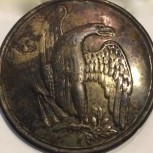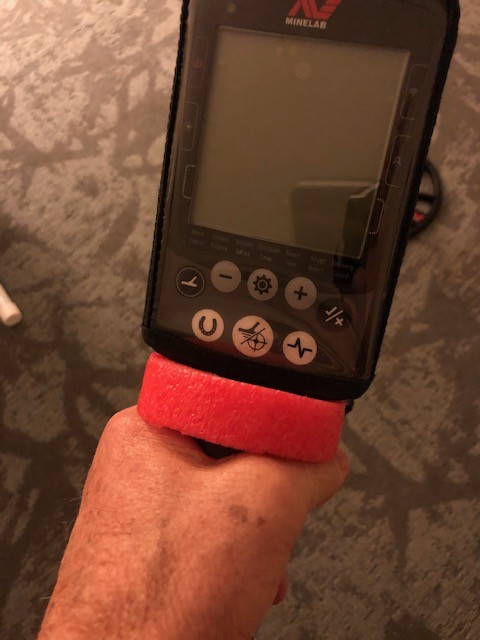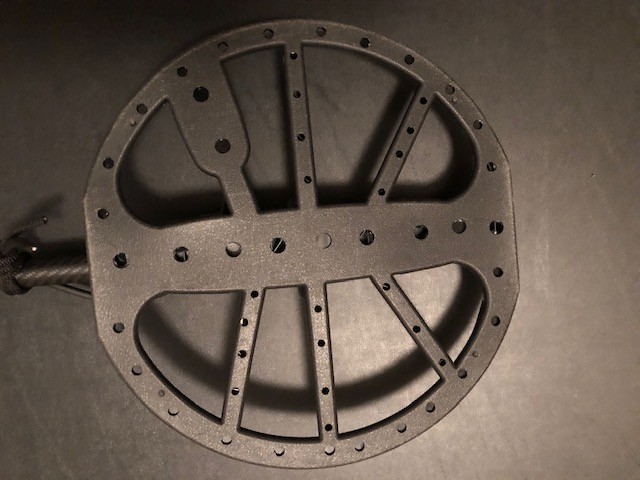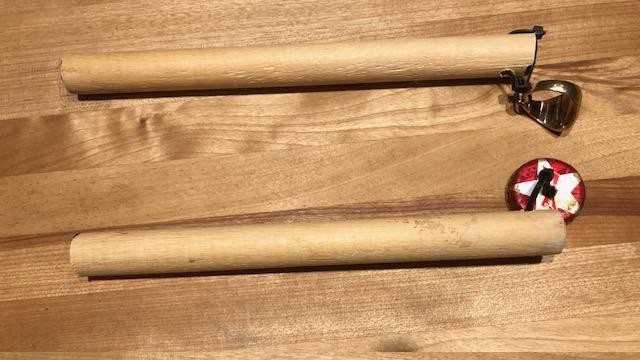-
Posts
591 -
Joined
-
Last visited
Content Type
Forums
Detector Prospector Home
Detector Database
Downloads
Everything posted by ColonelDan
-

Second Seminole Indian War Finds
ColonelDan replied to ColonelDan's topic in Metal Detecting For Coins & Relics
Thank you all for those kind words. I’ll update our progress on this site as events unfold. -

Second Seminole Indian War Finds
ColonelDan replied to ColonelDan's topic in Metal Detecting For Coins & Relics
No, it’s not the same site. -

Second Seminole Indian War Finds
ColonelDan replied to ColonelDan's topic in Metal Detecting For Coins & Relics
Another interesting button we found was one from the War of 1812. That's a script "I" for infantry. My research indicated that such buttons were re-issued from surplus 1812 vintage stock to the soldiers of the Seminole war period. -

Second Seminole Indian War Finds
ColonelDan replied to ColonelDan's topic in Metal Detecting For Coins & Relics
These were found pre-EQX. The team and I were using CTX 3030s and Excalibers. My CTX was set to 2 tones, open screen and optimized for relics. When relic hunting, I always use all metal and dig everything...iron artifacts are valued too. 😉 -
I and several detecting buddies supported a local museum a year ago by metal detecting a Second Seminole Indian War site that was occupied by the 2nd Dragoons from December 1837 to March of 1838. Below is just a sampling of our finds from that area. Many more uniform buttons, musket balls of various calibers and such not shown here came from our hunts. We suspect that one of their supply boats either sank or capsized since all the finds below were in the same general 25 square yard area. In digging down to retrieve these artifacts, I did hit wood deep in the muck ergo our thoughts that these finds came from a lost boat. The fort was constructed on the shores of a local lake and all finds thus far have been from that lake. We've yet to find the exact location of the fort itself but we have a good idea where it was. A modern road and house construction however prevents us from successfully searching the suspected area. dragoon uniform button period ring buttons and a few musket balls Bayonet with scabbard I found this breast plate in knee deep water and 16 inches deep in the lake muck, This is just the way it came from the muck. No cleaning was needed! raw anchor after encrustation was removed. It took two of us over 45 minutes to extract this anchor from the lake's muck. preserved anchor One of our displays we made for the museum. We'll be headed back to the site in the coming year.
-
Steve and Clive, Since Florida beach hunting is my life, I’ll add the view from my foxhole to this interesting discussion. Without rehashing the good points brought up by both Steve and Clive, I’ll just say that I’ve used both large coils and the stock coil searching our beaches and the surf. In the end, I now use the stock coils exclusively. Yes, the larger coil covers more ground with each swing but with less ease of use and reduced sensitivity as I’ve seen. As Steve says, the EQX was tuned for the 11” coil and I believe I’ve proven that...at least to myself. I know other well accomplished detectorists use the large coils on the beach and in the surf and with some success. To each his own, but for me, I prefer the enhanced sensitivity on low conductors the 11” coil seems to give me...as I always say however, that’s just the view (and preference) from my foxhole. Good job to both Clive and Steve. Salute!!
-

Ls.pelso Waterproof Headphones For The Minelab Equinox
ColonelDan replied to ColonelDan's topic in Minelab Equinox Forum
Thank you Clive. -
I've sometimes wondered why many in our hobby relate to pirates and use the pirate logo to symbolize their activity. I've also heard folks use the term "looter" to describe those hunting primarily on beaches. If we consult Webster, neither of those two describe our hobby in my mind: Pirate: a person who robs or commits illegal violence at sea or on the shores of the sea. any plunderer, predator, etc.: confidence men, slumlords, and other pirates. That's certainly doesn't describe the folks I know in this hobby! Loot/Looter anything taken by dishonesty, force, stealth, etc.: a burglar's loot. to carry off or take (something) as loot: to loot a nation's art treasures. to despoil by taking loot; plunder or pillage (a city, house, etc.), as in war. to take loot; plunder This doesn't fit either does it? We're not dishonest plunderers. So neither fits or describes what we do. Now a word that comes close but not quite is Scavenger a person who searches through and collects items from discarded material. But then the items we collect aren't really "discarded" are they? For the most part, they're lost So my simple soldier mind says that we are simply....Treasure Hunters Treasure Hunter: One who searches for anything of value or that which is highly prized. Yes, It's cold outside and our beaches aren't filled with depositors so I confess to being somewhat bored and have time on my hands right now but hey....I'm fully retired and therefore authorized to such free time, thoughts and wonderments! 😎 Soldier on....👍
-
I very much like your solution! I'll give that a try tomorrow. It's obvious to me that yours will be better than mine in water for sure and would serve the same purpose all around. Good job!!! 👍
-
I love clever ideas like this Sure Grip that makes detecting life easier. This is what I did before I saw the Sure Grip. I cut a swimming noodle to a convenient thickness, cut a slit in it so I could simply slip it around the top of the handle. It buffers the control box from weighing on my hand and stays on with no problem. It's nice and comfy but easily removed when cleaning my EQX. The Sure Grip however would be better when submerged in water.
-
I personally haven’t experienced any expansion or undue drag in the water as you describe.
-
Yes, a sand scoop is essential and a finds pouch is a "very nice to have" item. I've yet to detect in Hawaii but here are some general thoughts regarding beach hunting: Before you go, do the update 2.0 and use the F2 Iron Bias feature and then test a few targets you're most likely to find so you're familiar with what your EQX is telling you regarding a variety of those targets--coins, gold and silver jewelry. When you get to the beach, select Beach 1 mode and do a noise cancel first then ground balance. You'll most likely run into some very unfriendly sand conditions so you'll have to "dial in" the EQX to run as stable as possible. The relationship between recovery speed, the F2 setting and sensitivity will be key. Start by using Beach 1 on the dry and damp sand and Beach 2 on the wet sand and surf. Observe where the most people are on the beach...towel line, walk line, activity centers and about knee deep in the surf at low tide. Look for cuts in the sand where the surf has eroded the beach, low areas and ripples. Hit those areas with your coil low, level and slow. Grid the area to cover the area as thoroughly as possible. When you hit a target, I suggest you spiral around it to see if you have a coin line or other valuable targets in that same area. Good targets like gold tend to sink to similar depths. If you hit lead sinkers, stay in that area...its a good sign that gold is lurking nearby. I'm sure others, especially those who have hunted Hawaii, will add their thoughts, The folks on this forum are very friendly and eagerly willing to help! Good luck
-
A hunting buddy of mine does that and with no apparent issues...thus far. However, since I hunt exclusively and frequently on beaches, I've seen sand wear down any surface with ease and fairly quickly so I've always avoided swinging a naked coil on the beach--just my personal preference. If it works for you, go for it. As I always say, "If it ain't broke, don't fix it!" 😉
-
I've read a number of threads on the best way to cover and protect the coil and there's been a lot of good ideas for sure! I thought I'd add mine for those who primarily hunt sandy beaches like I do. Over the years, I've tried several ways to keep sand out since a build up between the coil and cover could and will result in a degree of false signals/chatter. What I finally determined was that sand is the "cleverest" of all elements with which I've had to contend. It can and does get into everything. No matter how well I thought I'd sealed the cover onto the coil, sand still managed to get in there...granted not much but my thinking is that if it's not supposed to be there, I want it outta there. And the one time I tried sealing the cover, it was he** to get the cover off! Conclusion; Sand will always get in but with most methods of sealing the cover, there's no way for it to get out! I decided to find a way to give those clever grains of sand a way out. I came up with this solution about 5 or 6 years ago and it's worked well for me on my Florida beaches. I simply drilled holes in the cover which allows the water to rinse out the sand while still protecting my coil from bumps and scrapes. After searching the dry and wet sand, a few swipes in the surf and the sand is rinsed away. When I get home and remove the cover, there is only a very few isolated grains between the coil and cover...not nearly enough to cause me any trouble whatsoever. Works for me but your mileage may vary and I'm always open to better ideas. Note: I drill the holes from the inside out so there are no ridges on the inside which would inhibit efficient draining. Just one method from my sandy foxhole.....
-
Great post Steve! Thanks.....
-
A question on another forum sparked my attention so I pulled out a few of mine to see how they rang up on the Equinox 800. The coins were laid separately on the ground so this was nothing more than an air test in Field 1. Coin Date VDI $0.50 1860 3 (California Gold fractional coin) $2.50 1925 15 $5.00 1881 18 $10.00 1888 21
-

Our Challenge Expressed In Numbers
ColonelDan replied to ColonelDan's topic in Metal Detecting For Jewelry
I totally agree! -

Our Challenge Expressed In Numbers
ColonelDan replied to ColonelDan's topic in Metal Detecting For Jewelry
Even if you shrink the size of the beach to 300 ft wide by 1 mile long ( normal for Daytona, Cocoa and St Pete) you're still looking at 19,008,000 sq inches. Now let's say through effective beach reading skills you focus on the towel line, wet sand and shallow surf. And let's say that reduces your actual search area by 50%. You're still looking at 9,504,000 square inches compared to the 95 sq inches in your 11" coil and you're still searching for that elusive 1 sq inch target! 😝 Pretty daunting eh? 😁 -
In my signature, I wrote that our challenge is : Big Beach, Little Coil, Tiny Targets. Just as an amusing exercise, I thought I'd see what that looks like in terms of square inches. 1 square mile of beach = 4,014,490,000 square inches Standard 11 inch coil = 95 square inches a good target = 1 square inch...maybe Given that reality, I think it's amazing we find what we do! Of course you can reduce that beach area with careful beach reading skills but you get the point! Big Beach, Little Coil, Tiny Targets.😁
-
“Do you use these covers to protect from saltwater spray?” Yes, Protection from salt spray and sand.
-
Allow me to suggest one more caution about full covers that I learned the hard way. Last June, I took my EQX to the Florida Keys and it was HOT!!!. I had a protective cover over the control box and after a short while, my EQX started to malfunction. The display went crazy and the buttons didn't work properly. I removed the cover, allowed the EQX to cool down and everything returned to normal operation. At that time, I made a "wild guess" that the cover, which covered up the speaker/vent holes in the back, may be preventing the EQX from "breathing properly." Again, just a guess at that point. I cut out part of the cover exposing the holes to the air and have not had a problem since and I hunt on Florida beaches year round. If this cover you describe is a full silicon cover and your hunting in hot weather, you may, and I say may, experience the same malfunction. I'd be very cautious were I you but that's just the view from my foxhole...Good luck.
-

Eqx Update 2.0: Conditions Change Significantly
ColonelDan replied to ColonelDan's topic in Minelab Equinox Forum
I hunt the dry sand in AM. I found disc works best in wet and surf. I use PP and have had no adverse effects in iron but again, that’s on the beach and we don’t have as much iron trash as on land. Our trash is mostly bottle caps, can slaw, pull tabs, and aluminum by far. Sometimes we have iron trash but it’s the above that gives us the most trouble. -

Eqx Update 2.0: Conditions Change Significantly
ColonelDan replied to ColonelDan's topic in Minelab Equinox Forum
I bury the sticks together about 2 inches apart. This time, the ring and cap were at the same depth...about 6 inches deep. My test is always done in the mode I’ll be using. In this case, Beach 1 and 2. -
I hit Cocoa Beach Friday and the conditions were much changed and improved over my hunt on Daytona Beach last Sunday. During that Sunday hunt, I reported my observations of the 2.0 update focusing on the F2 function. You can read it here: https://www.detectorprospector.com/forums/topic/10845-my-observations-of-eqx-update-201-and-iron-bias-f2-at-daytona-beach/ There was a lot of EMI on the Daytona beach that Sunday and the overall conditions were such that I found the sweet spot sensitivity settings ranged from 13-16. At Cocoa Beach, the conditions were markedly different which allowed me to range from 18-22. Regarding the F2 function, I found the sweet spot centered around level 5 at Cocoa. When I first arrived at the beach, I buried my test sticks to determine the best combination of sensitivity and iron bias. I define the sweet spot as that which gives me good separation on two distinct targets...a bottle cap and a gold ring...the bottle cap giving me a distinct iron grunt and the ring a nice mid tone. Sensitivity was set at 20 and F2 at 5. Anything higher than F2 at 6 and the gold ring was masked..a single tone. Any thing lower than 4 and the bottle cap increasingly rang up as a fairly good target...again, a single tone. Throughout the morning, I dug several targets that my EQX told me were bottle caps just to validate the F2 function...and by golly, each time the target was indeed a bottle cap! During the remainder of my hunt time, I trusted my 2.0 EQX and never dug another bottle cap unless it was one of those pure aluminum twist off caps and of course, pull tabs...they both still sound great...something we’ll just have to live with at this stage of metal detecting technology. Bottom Line: For those new to beach hunting, I can’t emphasize enough how important it is to “dial in” your settings as conditions do change from beach to beach. Secondly, I have great faith in the F2 function for the beaches I hunt.




